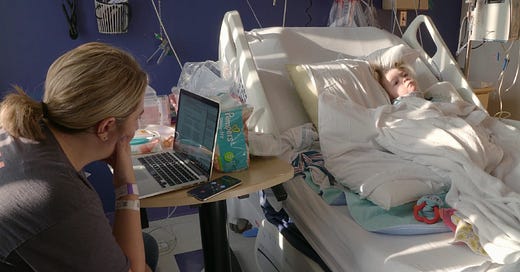The Zebra and the Bear
A mother's unrelenting quest to find a cure for her daughter's rare disease shows both the power -- and the pitfalls -- of when one person refuses to take no for an answer.
“The Zebra and the Bear” is the story of a mother and daughter, Amber Olsen and Willow Cannan, and the power of the unrelenting quest to find the cure for an extremely rare disease.
Directed by Patrick O'Connor over the course of seven years, it’s an intimate portrait of a family in crisis — and what happens when one woman refuses to take no for an answer. It also depicts the very human pitfalls and downsides of that incredible journey.
Willow was born with Multiple sulfatase deficiency, or MSD, which interferes with the body’s natural enzymes and disposal of secretions. In her case, she was a seemingly pretty normal toddler who over time lost the ability to walk and talk.
It’s so rare that only about 15 children in the U.S. had it around the time the documentary begins tracking their progress in 2017. And therein lies the problem.
It costs millions and millions of dollars — sometimes billions — to bring a new drug or treatment to patients. In the case of MSD, the solution is somewhat simpler in that they can attack the problem by designing a gene therapy. Essentially, scientists manufacture a virus to attack the mutated gene and replace it with a healthy one.
But that takes years, money and expertise — all things Amber lacks. So she makes it her personal quest to overcome these obstacles.
One thing we learn in talking to a host of scientists, doctors and advocates is there’s not a lot of support out there for rare disease therapies, from both the monetary and clinical side, because by definition very few people will benefit from it.
“It'll save kids, but it won't make a profit,” Amber succinctly puts it.
Amber launches a multi-year campaign to raise money for the initial research phase involving mice. They host fundraising concerts, shoot videos to appeal to the sympathetic, and talk to lawmakers about getting more funding from the National Institutes of Health for rare disease research.
Amber is probably not your typical heroic figure you’d expect to see in a movie like this. A take-charge business owner, she can come across as brusque, even pushy. There’s an uncomfortable scene where she demands the crowd quiet down at an outdoor concert event to hear her pitch. She’s got the “mom stare” down pat.
Good for her. If a few people’s feelings are left a little bruised, sometimes it takes a little pain to spur them to action.
This odyssey does have other impacts, though — on their business, on their two teen daughters, on Amber’s marriage to her husband, Tom, a retired military guy. There’s no easy good guy/bad guy kind of dynamic or agenda on the part of the filmmakers. It’s just a very authentic depiction of the reality that kids with terminal illnesses put tremendous strain on a marriage.
The film follows the family closely for a few years, and then there’s an understandable break at the outset of the Covid pandemic. I did feel like there were some open questions that were left answered. For example, early on Amber tells us that Willow is the zebra and she is the bear, and the striped zebra theme is present in all their campaigning. But it’s never explained how they identified with those animals.
We see all the various therapies, appointments and attention needed to keep Willow going. Twice a day she has to be put into a vibrating vest to help her body dispose of its secretions. Amber and Tom face a choice of whether or not to get her a tracheotomy, knowing it may extend her life but diminish the quality of it going forward.
Because MSD is a progress disease, an open question is whether she’ll even be eligible for the clinical trial, should they ever reach that stage. It’s a staggering dilemma no one, especially a parent, should ever have to face.
It’s a heartbreaking documentary, but also an uplifting one.
“The Zebra and the Bear” is available for hosted screenings through Roco Films.





